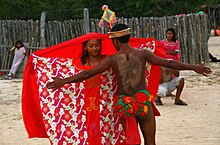The Indigenous peoples of South America or South American Indigenous peoples, are the pre-Columbian peoples of South America and their descendants. These peoples contrast with South Americans of European ancestry and those of African descent.
| Total population | |
|---|---|
| Approximately 18 million | |
| Regions with significant populations | |
| 5.9 million (2017)[1] | |
| 4.1 million (2012)[2] | |
| 2.4 million (2017)[3] | |
| 1.7 million (2022)[4] | |
| 1.9 million (2018)[5] | |
| 1.3 million (2022)[6] | |
| 1.3 million (2023)[7] | |
| 724,592 (2011)[8] | |
| 117,150 (2012)[9] | |
| 78,492 (2012)[10] | |
| 76,452 (2021)[11] | |
| 20,344 (2012)[12] | |
| ~19,000[13] | |
| Languages | |
| Indigenous languages of the Americas, Quechua, Aymara, Guarani, Mapuche | |
| Religion | |
| Related ethnic groups | |
| Indigenous people of the Americas | |


In Spanish, Indigenous people are often referred to as indígenas or pueblos indígenas (lit. Indigenous peoples). They may also be called pueblos nativos or nativos (lit. Native peoples). The term aborigen (lit. aborigine) is used in Argentina and pueblos aborígenes (lit. aboriginal peoples) is commonly used in Colombia. The English term "Amerindian" (short for "Indians of the Americas") is often used in the Guianas. Latin Americans of mixed European and Indigenous descent are usually referred to as mestizos (Spanish) and mestiços (Portuguese), while those of mixed African and Indigenous ancestry are referred to as zambos.
It is believed that the first human populations of South America either arrived from Asia into North America via the Bering Land Bridge and migrated southwards or alternatively from Polynesia across the Pacific.[14][15][16] The earliest generally accepted archaeological evidence for human habitation in South America dates to 14,000 years ago, the Monte Verde site in Southern Chile.[17] The descendants of these first inhabitants would become the indigenous populations of South America.
Before the Spanish colonization of the Americas, many of the indigenous peoples of South America were hunter-gatherers and indeed many still are, especially in the Amazonian area. Others, especially the Andean cultures, practised sophisticated agriculture, utilized advanced irrigation and kept domesticated livestock, such as llamas and alpacas.[18][19][20]
In the present day, there is one South American country where indigenous peoples constitute the largest ethnic group. This is Bolivia, where 62% of people identify as feeling a part of some indigenous group.[21]
South American indigenous peoples include:
- Indigenous peoples in Argentina
- Indigenous peoples in Bolivia
- Indigenous peoples in Brazil
- Indigenous peoples in Chile
- Indigenous peoples in Colombia
- Indigenous peoples in Ecuador
- Indigenous peoples in French Guiana
- Indigenous peoples in Guyana
- Indigenous peoples in Paraguay
- Indigenous peoples in Peru
- Indigenous peoples in Suriname
- Indigenous peoples in Uruguay
- Indigenous peoples in Venezuela
See also
References
External links
